目录
-
- [1. 窗体设置](#1. 窗体设置)
- [2. 字体图标](#2. 字体图标)
- [3. 控件模板](#3. 控件模板)
- [4. 页面逻辑](#4. 页面逻辑)
-
- [4.1. 不使用MVVM](#4.1. 不使用MVVM)
- [4.2. MVVM模式实现](#4.2. MVVM模式实现)
本篇我们开发一个基于MVVM的登录页面,用来回顾下之前学习的内容
登录页面如下:
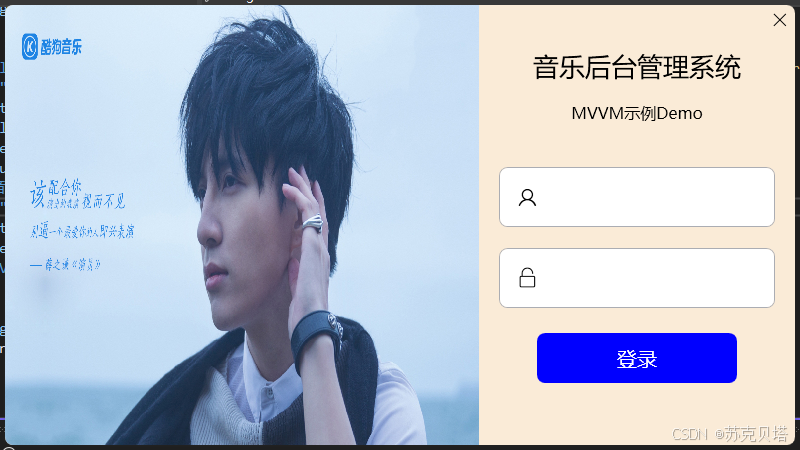
窗体取消了默认的标题栏,调整为带阴影的圆角窗体,左侧放一张登录背景图,右边自绘了一个关闭按钮,文本框和按钮也做了美化。快速来看一下如何实现的。
1. 窗体设置
窗口样式调整为None,不允许调整窗口大小,用Border包裹整个窗体实现圆角以及阴影效果,整体分两部分 - 左侧图片、右侧背景图:
xml
<Window x:Class="MVVMDemo.MainView"
xmlns="http://schemas.microsoft.com/winfx/2006/xaml/presentation"
xmlns:x="http://schemas.microsoft.com/winfx/2006/xaml"
xmlns:d="http://schemas.microsoft.com/expression/blend/2008"
xmlns:local="clr-namespace:MVVMDemo"
xmlns:mc="http://schemas.openxmlformats.org/markup-compatibility/2006"
Title="MainView"
Width="800"
Height="450"
AllowsTransparency="True"
Background="{x:Null}"
ResizeMode="NoResize"
WindowStartupLocation="CenterScreen"
WindowStyle="None"
mc:Ignorable="d">
<Border Margin="5" Background="AntiqueWhite" CornerRadius="8">
<Border.Effect>
<DropShadowEffect BlurRadius="5"
Direction="0"
Opacity="0.3"
ShadowDepth="0"
Color="Gray" />
</Border.Effect>
<Grid>
<Grid.ColumnDefinitions>
<ColumnDefinition Width="6*" />
<ColumnDefinition Width="4*" />
</Grid.ColumnDefinitions>
<Border CornerRadius="8,0,0,8">
<Border.Background>
<ImageBrush ImageSource="./Assets/Images/LoginBackground.png" Stretch="Fill" />
</Border.Background>
</Border>
<Border Grid.Column="1" CornerRadius="0,8,0,8">
... // 内容部分
</Border>
</Grid>
</Border>
</Window>2. 字体图标
去阿里巴巴矢量图标库选好要用的图标,添加入库,然后下载下来添加至项目:
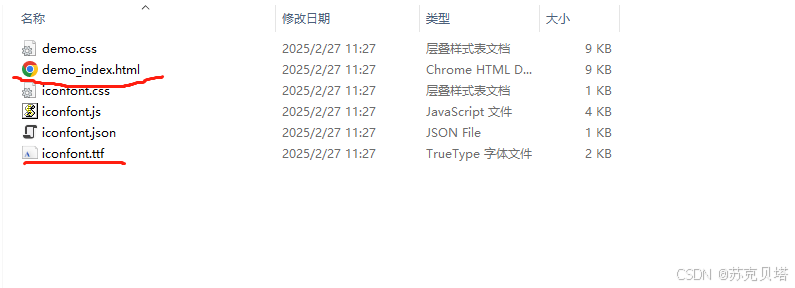
主要用上面勾选的两个文件,html文件是下载的图标演示,tff是程序中用到的字体文件了,把它放到新建的Assets资源文件夹下边:
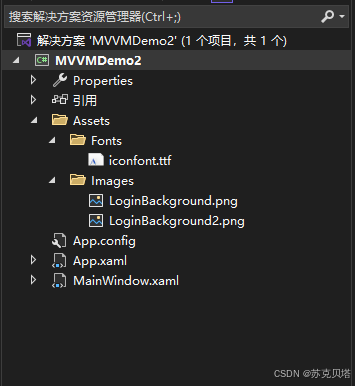
之后就可以用了,Text内容可以从演示的html中找到,也可以在矢量图项目里面复制代码:
<TextBox Text="" FontFamily="./Assets/Fonts/#iconfont"/>
3. 控件模板
模板内容因为只在这一个登录窗体上使用,就都定义在车Window.Resources窗体资源里了,所以看上去页面内容有点多,大家也可以单独定义资源文件。先说按钮,两个按钮都是通过自定义控件模板来完成的,关闭按钮主要是定义了一个 Path 控件,用于绘制一个 "X" 形状,类似于关闭按钮的图标,登录按钮就直接用 TextBlock 代替的:
xml
<ControlTemplate x:Key="CloseButton" TargetType="Button">
<Border Name="back" Background="Transparent" CornerRadius="0,8,0,0">
<Path HorizontalAlignment="Center"
VerticalAlignment="Center"
Data="M0 0 12 12M0 12 12 0"
Stroke="Black"
StrokeThickness="1" />
</Border>
<ControlTemplate.Triggers>
<Trigger Property="IsMouseOver" Value="true">
<Setter TargetName="back" Property="Background" Value="red" />
</Trigger>
</ControlTemplate.Triggers>
</ControlTemplate>
<ControlTemplate x:Key="LoginButton" TargetType="Button">
<Border Name="back" Background="{TemplateBinding Background}" CornerRadius="8">
<TextBlock Text="登录" VerticalAlignment="Center" HorizontalAlignment="Center"/>
</Border>
<ControlTemplate.Triggers>
<Trigger Property="IsMouseOver" Value="true">
<Setter TargetName="back" Property="Background" Value="red"/>
</Trigger>
</ControlTemplate.Triggers>
</ControlTemplate>图标属性因为Text属性要获取输入的文本,所以改成了通过文本框的 Tag 属性绑定内容。
而后的控件布局就不解释了吧,直接看代码吧:
xml
<Window x:Class="MVVMDemo2.MainWindow"
xmlns="http://schemas.microsoft.com/winfx/2006/xaml/presentation"
xmlns:x="http://schemas.microsoft.com/winfx/2006/xaml"
xmlns:d="http://schemas.microsoft.com/expression/blend/2008"
xmlns:local="clr-namespace:MVVMDemo2"
xmlns:mc="http://schemas.openxmlformats.org/markup-compatibility/2006"
Title="MainView"
Width="800"
Height="450"
AllowsTransparency="True"
Background="{x:Null}"
ResizeMode="NoResize"
WindowStartupLocation="CenterScreen"
WindowStyle="None"
mc:Ignorable="d">
<Window.Resources>
<ControlTemplate x:Key="CloseButton" TargetType="Button">
<Border Name="back" Background="Transparent" CornerRadius="0,8,0,0">
<Path HorizontalAlignment="Center"
VerticalAlignment="Center"
Data="M0 0 12 12M0 12 12 0"
Stroke="Black"
StrokeThickness="1" />
</Border>
<ControlTemplate.Triggers>
<Trigger Property="IsMouseOver" Value="true">
<Setter TargetName="back" Property="Background" Value="red" />
</Trigger>
</ControlTemplate.Triggers>
</ControlTemplate>
<ControlTemplate x:Key="LoginButton" TargetType="Button">
<Border Name="back" Background="{TemplateBinding Background}" CornerRadius="8">
<TextBlock Text="登录" VerticalAlignment="Center" HorizontalAlignment="Center"/>
</Border>
<ControlTemplate.Triggers>
<Trigger Property="IsMouseOver" Value="true">
<Setter TargetName="back" Property="Background" Value="red"/>
</Trigger>
</ControlTemplate.Triggers>
</ControlTemplate>
<SolidColorBrush x:Key="TextBox.Static.Border" Color="#FFABAdB3"/>
<SolidColorBrush x:Key="TextBox.MouseOver.Border" Color="#FF7EB4EA"/>
<SolidColorBrush x:Key="TextBox.Focus.Border" Color="#FF569DE5"/>
<Style x:Key="IconTextBoxStyle" TargetType="{x:Type TextBox}">
<Setter Property="Background" Value="{DynamicResource {x:Static SystemColors.WindowBrushKey}}"/>
<Setter Property="BorderBrush" Value="{StaticResource TextBox.Static.Border}"/>
<Setter Property="Foreground" Value="{DynamicResource {x:Static SystemColors.ControlTextBrushKey}}"/>
<Setter Property="BorderThickness" Value="1"/>
<Setter Property="KeyboardNavigation.TabNavigation" Value="None"/>
<Setter Property="HorizontalContentAlignment" Value="Left"/>
<Setter Property="FocusVisualStyle" Value="{x:Null}"/>
<Setter Property="AllowDrop" Value="true"/>
<Setter Property="ScrollViewer.PanningMode" Value="VerticalFirst"/>
<Setter Property="Stylus.IsFlicksEnabled" Value="False"/>
<Setter Property="Template">
<Setter.Value>
<ControlTemplate TargetType="{x:Type TextBox}">
<Border x:Name="border" Background="{TemplateBinding Background}" BorderBrush="{TemplateBinding BorderBrush}" BorderThickness="{TemplateBinding BorderThickness}" SnapsToDevicePixels="True" CornerRadius="8">
<Grid>
<Grid.ColumnDefinitions>
<ColumnDefinition Width="2*"/>
<ColumnDefinition Width="8*"/>
</Grid.ColumnDefinitions>
<TextBlock FontFamily="./Assets/Fonts/#iconfont" Text="{TemplateBinding Tag}" FontSize="20" VerticalAlignment="Center" HorizontalAlignment="Center" />
<ScrollViewer Grid.Column="1" x:Name="PART_ContentHost" Focusable="false" HorizontalScrollBarVisibility="Hidden" VerticalScrollBarVisibility="Hidden" VerticalAlignment="Center"/>
</Grid>
</Border>
<ControlTemplate.Triggers>
<Trigger Property="IsEnabled" Value="false">
<Setter Property="Opacity" TargetName="border" Value="0.56"/>
</Trigger>
<Trigger Property="IsMouseOver" Value="true">
<Setter Property="BorderBrush" TargetName="border" Value="{StaticResource TextBox.MouseOver.Border}"/>
</Trigger>
<Trigger Property="IsKeyboardFocused" Value="true">
<Setter Property="BorderBrush" TargetName="border" Value="{StaticResource TextBox.Focus.Border}"/>
</Trigger>
</ControlTemplate.Triggers>
</ControlTemplate>
</Setter.Value>
</Setter>
<Style.Triggers>
<MultiTrigger>
<MultiTrigger.Conditions>
<Condition Property="IsInactiveSelectionHighlightEnabled" Value="true"/>
<Condition Property="IsSelectionActive" Value="false"/>
</MultiTrigger.Conditions>
<Setter Property="SelectionBrush" Value="{DynamicResource {x:Static SystemColors.InactiveSelectionHighlightBrushKey}}"/>
</MultiTrigger>
</Style.Triggers>
</Style>
</Window.Resources>
<Border Margin="5" Background="AntiqueWhite" CornerRadius="8">
<Border.Effect>
<DropShadowEffect BlurRadius="5"
Direction="0"
Opacity="0.3"
ShadowDepth="0"
Color="Gray" />
</Border.Effect>
<Grid>
<Grid.ColumnDefinitions>
<ColumnDefinition Width="6*" />
<ColumnDefinition Width="4*" />
</Grid.ColumnDefinitions>
<Border CornerRadius="8,0,0,8">
<Border.Background>
<ImageBrush ImageSource="./Assets/Images/LoginBackground.png" Stretch="Fill" />
</Border.Background>
</Border>
<Border Grid.Column="1" CornerRadius="0,8,0,8">
<Grid>
<Grid.RowDefinitions>
<RowDefinition Height="3*" />
<RowDefinition Height="7*" />
</Grid.RowDefinitions>
<StackPanel>
<Button Width="30" Height="30" HorizontalAlignment="Right" Template="{StaticResource ResourceKey=CloseButton}" />
<TextBlock Margin="15"
HorizontalAlignment="Center"
VerticalAlignment="Center"
FontSize="26"
Foreground="Black"
Text="**管理系统" />
<TextBlock Margin="5"
HorizontalAlignment="Center"
FontSize="16"
Text="MVVM示例Demo" />
</StackPanel>
<Grid Grid.Row="1" Margin="20,20">
<Grid.RowDefinitions>
<RowDefinition Height="3*" />
<RowDefinition Height="3*" />
<RowDefinition Height="3*" />
<RowDefinition Height="1*" />
</Grid.RowDefinitions>
<TextBox Style="{DynamicResource IconTextBoxStyle}" Tag="" Height="60" FontSize="15"/>
<TextBox Grid.Row="1" Style="{DynamicResource IconTextBoxStyle}" Tag="" Height="60" FontSize="15" />
<Button Grid.Row="2" Width="200" Height="50" Template="{StaticResource LoginButton}" Background="Blue" Foreground="White" FontSize="20"/>
</Grid>
</Grid>
</Border>
</Grid>
</Border>
</Window>4. 页面逻辑
4.1. 不使用MVVM
在不使用MVVM情况下实现点击登录:点击登录按钮获取输入的用户名密码,验证是否正确,正确则创建页面隐藏当前页:
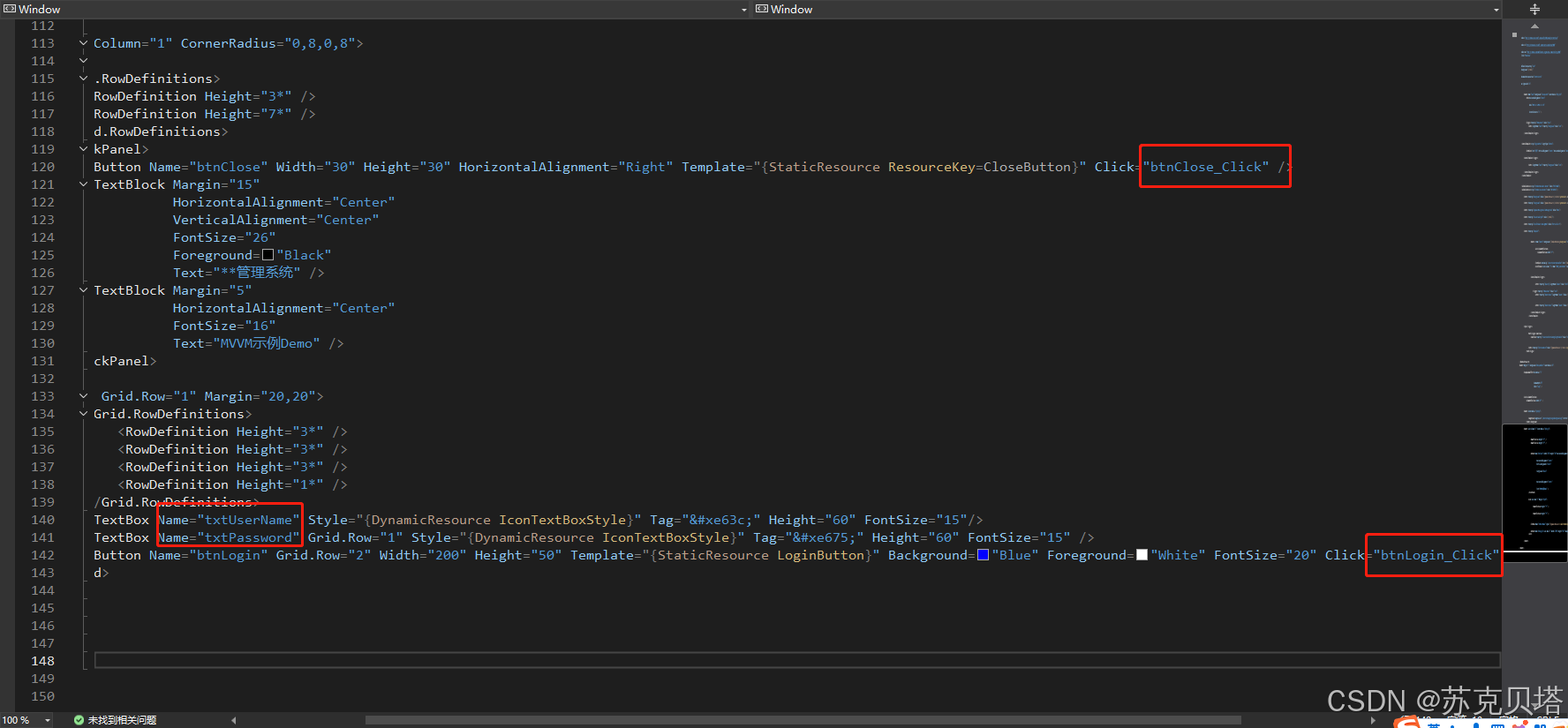
后台Login.xaml.cs:
csharp
private void btnClose_Click(object sender, RoutedEventArgs e)
{
this.Close();
}
private void btnLogin_Click(object sender, RoutedEventArgs e)
{
if (txtUserName.Text == "admin" && txtPassword.Text == "123456")
{
MainWindow main = new MainWindow();
main.Show();
this.Close();
}
else
{
MessageBox.Show("用户名或密码错误。");
}
}现在所有东西是耦合在一起的,虽然这样看起来实现起来比较快,但是在后期维护起来是非常麻烦的,尤其是工程代码量大了以后,假如其中任何一个环节发生了变化,程序就会出问题,简而言之就是牵一发而动全身。
4.2. MVVM模式实现
接下来看一下MVVM模式实现方式:
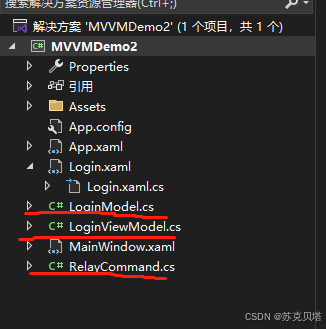
- Model部分
这部分主要是登录页面的数据部分,涉及两个字段,用户名和密码:
LoginModel.cs:
csharp
public class LoginModel
{
private string _UserName;
public string UserName
{
get { return _UserName; }
set { _UserName = value; }
}
private string _Password;
public string Password
{
get { return _Password; }
set { _Password = value; }
}
}- View部分
视图部分主要做数据的呈现,通过绑定和命令解耦图形界面和数据以及执行动作之间的关系,数据之间的交互在用户名和密码文本框:

动作有两个,一个是关闭按钮,另一个是登录按钮。关闭按钮只是关闭当前窗体,不涉及业务交互,所以保留之前的Click事件即可,登录按钮就涉及到视图、数据以及业务逻辑了,这就需要通过命令来完成。
- ViewModel部分
在这之前需要完成命令接口的定义,新建一个文件:RelayCommand.cs实现ICommand接口:
csharp
public class RelayCommand : ICommand
{
private readonly Action _execute; // 需要执行的操作(命令体)
private readonly Func<bool> _canExecute; // 命令是否可以执行的逻辑
public RelayCommand(Action action, Func<bool> canExecute)
{
_execute = action;
_canExecute = canExecute;
}
public bool CanExecute(object parameter) // ICommand接口方法之一,用于判断命令是否可以执行
{
if (_canExecute == null)
{
return true; // 命令始终可以执行
}
else
{
return _canExecute(); // 调用 _canExecute() 获取判断结果
}
}
public void Execute(object parameter) // ICommand接口方法之一 用于执行命令体,调用 _execute 所存储的操作
{
_execute?.Invoke();
}
public event EventHandler CanExecuteChanged // ICommad接口中的事件,当命令的可执行状态发生变化时,触发此事件来通知界面元素更新
{
add
{
if (_canExecute != null) { CommandManager.RequerySuggested += value; }
}
remove
{
if (_canExecute != null) { CommandManager.RequerySuggested -= value; }
}
}
}这样就完成了命令接口的实现,接着来看ViewModel视图模型,视图模型作为沟通数据Model和视图View之间的桥梁,就得多干一些活了。
首先是数据部分,为了更好的解耦,不让图形界面与数据产生直接交互,在ViewModel里嵌套一层在获取Model以及View部分的数据并完成验证处理、数据更新还有命令操作:
LoginViewModel.cs:
csharp
public class LoginViewModel : INotifyPropertyChanged
{
public event PropertyChangedEventHandler PropertyChanged;
private LoginModel _loginModel;
private Login _loginView;
public LoginViewModel(Login view)
{
_loginModel = new LoginModel();
_loginView = view;
}
// 绑定到登录界面文本框的属性,用于获取和设置用户名和密码
public string UserName
{
get { return _loginModel.UserName; }
set
{
_loginModel.UserName = value;
OnPropertyChanged(UserName);
}
}
public string Password
{
get { return _loginModel.Password; }
set
{
_loginModel.Password = value;
OnPropertyChanged(Password);
}
}
protected virtual void OnPropertyChanged([CallerMemberName] string propertyName = null) // 触发属性更改通知的方法
{
PropertyChanged?.Invoke(this, new PropertyChangedEventArgs(propertyName));
}
private void LoginFunc() // 处理登录操作
{
if (UserName == "admin" && Password == "123456")
{
MainWindow main = new MainWindow();
main.Show();
_loginView.Close();
}
else
{
MessageBox.Show("用户名或密码错误");
UserName = "";
Password = "";
}
}
private bool CanLoginExecute()
{
return true;
}
public ICommand LoginAction // 绑定到登录按钮的命令属性
{
get
{
return new RelayCommand(LoginFunc, CanLoginExecute); //(执行体,判断条件)
}
}
}完成了沟通部分的桥梁怎样,和其他两部分取得联系呢?数据部分,通过属性更新已经通知到了,视图部分就需要通过绑定数据上下文来完成了:
Login.xaml.cs:
csharp
public partial class Login : Window
{
public Login()
{
InitializeComponent();
this.DataContext = new LoginViewModel(this);
}
private void btnClose_Click(object sender, RoutedEventArgs e)
{
this.Close();
}
}以上一个简单的MVVM示例就完成了,怎么说呢,虽然看着很简单,代码也没多少,但是对初学者来说绝非易事。希望大家能多多练习,多多思考,多多总结,多多交流,多多进步。
详细代码我上传到gitee:https://gitee.com/zypapa100/MVVMPractice